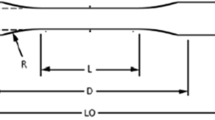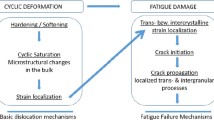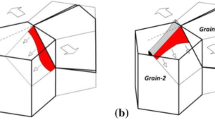Abstract
Three typical interactions of persistent slip bands (PSBs) with different types of grain boundaries (GBs) were investigated and analyzed in fatigued copper crystals. The results show that PSBs cannot transfer through all types of large-angle GBs, regardless of their orientation with respect to the stress axis. Secondary slip was often observed near the GBs, leading to strain incompatibility. When the slip systems of the two adjacent crystals are coplanar, the transmission of a PSB across a GB strongly depends on the slip directions of the two adjacent crystals. It was found that only the low-angle GBs can be passed through by PSBs, and accordingly they are insensitive to intergranular fatigue cracking. For a special copper bicrystal with coplanar slip systems, the ladderlike dislocation arrangements within the adjacent PSBs become discontinuous and a dislocation-affected-zone appears near the GB due to the difference in the slip direction of the two adjacent crystals. Therefore, the necessary conditions for the transmission of a PSB across a GB are that the neighboring grains have a coplanar slip system and identical slip directions.
Similar content being viewed by others
References
Z. Shen, R.H. Wagoner, and A.T. Clark, Acta Mater. 36, 3231 (1988).
T.C. Lee, I.M. Robertson, and H.K. Birnbaum, Philos. Mag. A 62, 131 (1990).
X. Baillin, J. Pelissier, A. Jacques, and A. George, Philos. Mag. A 61, 329 (1990).
W. Liu, M. Bayerlein, H. Mughrabi, A. Day, and P.N. Quested, Acta Metall. Mater. 40, 1763 (1992).
C. Laird, P. Charsley, and H. Mughrabi, Mater. Sci. Eng. 81, 433 (1986).
T. Luoh and C.P. Chang, Acta Mater. 44, 2683 (1996).
Z.F. Zhang and Z.G. Wang, Acta Mater. 49, 2875 (2001).
A.J. Wilkinson, M.B. Henderson, and J.M. Martin, Philos. Mag. Lett. 74, 145 (1996).
Z.F. Zhang and Z.G. Wang, Acta Mater. 46, 5063 (1998).
H. Mughrabi, Mater. Sci. Eng. 33, 207 (1978).
Y.M. Hu and Z.G. Wang, Mater. Sci. Eng. A 234–236, 98 (1997).
Z.F. Zhang and Z.G. Wang, Philos. Mag. A 79, 741 (1999).
P. Peralta and C. Laird, Acta Mater. 45, 3029 (1997).
Z.F. Zhang, Z.G. Wang, and S.X. Li, Fatigue Fract. Engr. Mater. Struct. 21, 1307 (1998).
Z.F. Zhang and Z.G. Wang, Philos. Mag. A 81, 399 (2001).
Z.F. Zhang and Z.G. Wang, Philos. Mag. Lett. 80, 483 (2000).
Author information
Authors and Affiliations
Corresponding author
Rights and permissions
About this article
Cite this article
Zhang, Z.F., Wang, Z.G. & Eckert, J. What types of grain boundaries can be passed through by persistent slip bands?. Journal of Materials Research 18, 1031–1034 (2003). https://doi.org/10.1557/JMR.2003.0141
Received:
Accepted:
Published:
Issue Date:
DOI: https://doi.org/10.1557/JMR.2003.0141




